sunlight
Types of sun and shade
It is best to determine how much sunlight a spot in your yard receives before you decide what to plant. The most useful time to define sun and shade is near the summer solstice, when shadows are the shortest. This ensures that shade will be present for plants that cannot tolerate strong sun and provides an accurate count of sun hours.
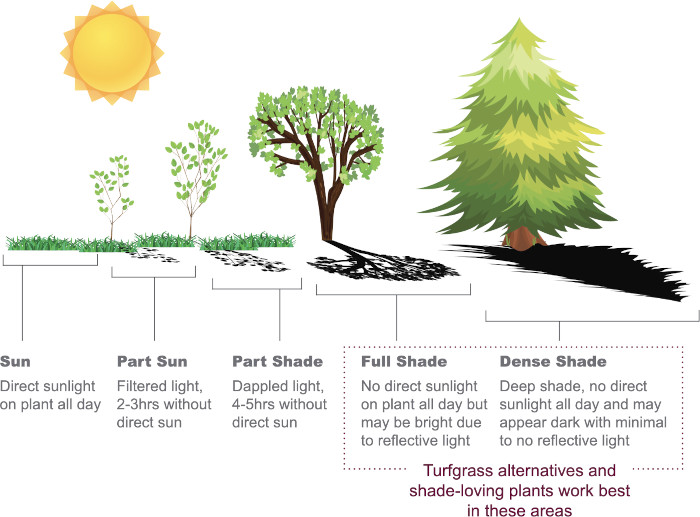 TX Extension Shade Gardening
TX Extension Shade Gardening
Note that full shade means less than two hours of sun, with ¼ to ½ of the sky visible.
Sunlight strength
Sunlight strength varies by locale and environmental conditions:
- The sun’s angle, which differs with latitude, season and time of day
- Altitude
- Interference from cloud cover or air pollution
- Aspect, which is the slope plus the compass direction that the garden faces
Why is this important? The amount of solar radiation that plants receive determines how effectively they can photosynthesize. Note that photosynthesis is also dependent on temperature and soil moisture.
locale
The figure below shows how dramatically photosynthetically active solar radiation (PAR) varies across the continental US. If you moved to our area from a different locale, even within our state, the amount of PAR may be quite different from that at your former home. Many plants that perform best with full sun further north will prefer afternoon shade in our area.
The average monthly PAR for Orange county is shown next to each map. We receive 2.25 to 3.3 times more PAR in June than in December or January.
 Faust JE and Logan J Daily Light Integral: A Research Review and High-resolution Maps of the United States
Faust JE and Logan J Daily Light Integral: A Research Review and High-resolution Maps of the United States
season
The sun’s angle in the sky varies with the season. The image below shows the sun’s position at noon during each season.
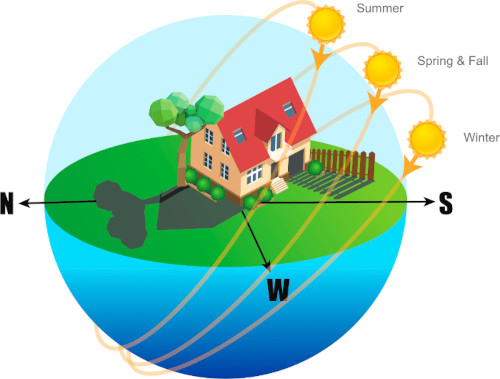 TX Extension Shade Gardening
TX Extension Shade Gardening
Due to the different angle of the sun in the sky, the patterns of shade cast by trees differ in summer vs. winter:
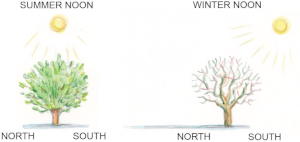
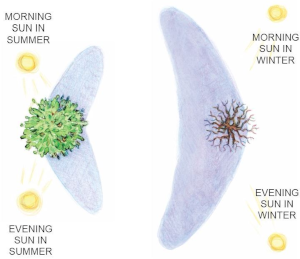 Leaf Network Sun and Shade Patterns
Leaf Network Sun and Shade Patterns
aspect
In gardening, aspect refers to the compass direction from which the sun strikes an area in you yard. Aspect determines the strength of sunlight and the shadows cast by objects.
The figures below show shadows cast at different times of day for a house facing the indicated direction. While the shadow patterns for morning and afternoon are similar for opposite aspects (e.g., eastern aspect in the morning is similar to western aspect in the afternoon), the amount of solar radiation that the two aspects receive over the course of the day is quite different. A western exposure receives much more solar radiation than an eastern exposure. This is because noon and afternoon sunlight is much stronger than morning sunlight. The same is true for a southern vs. a northern exposure.
southern exposure
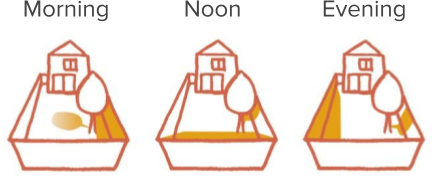 BBC Gardeners’ World Types of garden shade
BBC Gardeners’ World Types of garden shade
- Sun most of the day, but you can create shade by planting trees
- Warmer and drier
- Warms up earlier in the spring
northern exposure
 BBC Gardeners’ World Types of garden shade
BBC Gardeners’ World Types of garden shade
- Shade most of the day for a large or tall barrier (house, woods), but planting about 10 feet away from the barrier provides more sun
- Cooler but more even temperature (fewer extremes of hot and cold)
- Warms up later in the spring
- Can be windy in fall and winter
eastern exposure
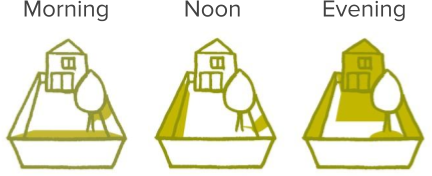 BBC Gardeners’ World Types of garden shade
BBC Gardeners’ World Types of garden shade
- Afternoon shade
- Cooler than southern or western exposure
western exposure
 BBC Gardeners’ World Types of garden shade
BBC Gardeners’ World Types of garden shade
- Afternoon sun
- Can be windy in spring and summer
Now, let’s look at the effect of a slope. The figure below shows that in our area, a north-facing slope receives less sun per unit area than a south-facing slope. The yellow beams represent identical amounts of solar radiation. The red areas show how much of the energy reaches each slope.
 U of British Columbia Aspect Effects
U of British Columbia Aspect Effects
You can see a local example of the dramatic effect that a combination of slope and aspect creates on the steep north slope of Occoneechee Mountain in Hillsborough. Our area is normally too hot and dry for plants that are happy in the Appalachian mountains. However, this steep north slope is a special microclimate that has allowed plants normally found only in the Appalachians to persist here since the ice age. These include:
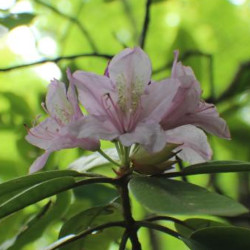 ncparks.gov catawba rhododendron
ncparks.gov catawba rhododendron
- Bradley’s spleenwort
- wild sarsaparilla
- Catawba rhododendron
- mountain laurel
- galax
- sweet pinesap
- large witch-alder
- purple fringeless orchid
